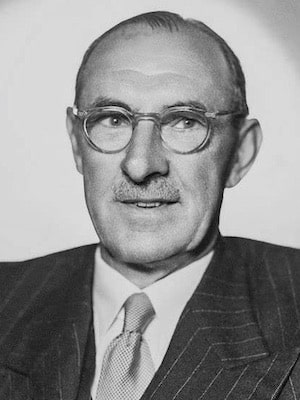Norman Gregg

Sir Norman McAlister Gregg (1892-1966) was an Australian ophthalmologist
Gregg’s findings had major implications for clinical medicine, basic research and public health. His work, and that of other studies confirming his initial observations, showed that rubella, previously regarded as a mild infectious disease, could cause cataracts and other significant birth defects if susceptible women became infected in the first few months of pregnancy.
Gregg’s findings accelerated development in teratology and also brought hope for primary prevention of birth defects.
Biography
- Born on March 7, 1892 at Burwood, Sydney. Educated at Homebush and Sydney grammar schools
- 1915 – M.B., Ch.M., University of Sydney. Represented the State of New South Wales and the University of Sydney at cricket and tennis; Half blue for baseball; also represented University in swimming and baseball; and played for a local ice hockey team…
- 1915-1918 Joined the British Expeditionary Force, serving in France; Military Cross for gallantry in the field
- 1919 – Resident medical officer, Royal Prince Alfred Hospital.
- 1922 – Returned to England to train as an ophthalmologist; house surgeon at Moorfields Eye Hospital, the Royal Westminster Ophthalmic Hospital and the Birmingham and Midland Eye Hospital
- 1923 – Ophthalmic surgeon at Macquarie Street, Sydney; honorary appointments at the Royal Prince Alfred Hospital and the Royal Alexandra Hospital for Children
- 1930 – President of the Ophthalmological Society of N.S.W
- 1939-1951 Lecturer in Ophthalmology, University of Sydney
- 1941 – Delivered his paper on ‘Congenital Cataract following German Measles in the Mother’ to the Ophthalmological Society of Australia (later published in its Transactions)
- 1946 – Awarded first Shorney Prize for “the most substantial contribution to the knowledge of ophthalmology” by an Australian
- 1951– Received the Charles Mickle fellowship of the University of Toronto for “that member of the medical profession who is considered to have done the most during the preceding ten years to advance sound knowledge of a practical kind in medical art or science”
- 1953 – Knighted, for his services to medicine
- 1959-1966 President of the board of management of the Royal Alexandra Hospital
- 1963– Elected as Fellow of the Australian Postgraduate Federation in Medicine
- 1964– Awarded the Britannica Australia Award in Medicine (a shared award with Dr Kate Campbell)
- Died on July 27, 1966 in Sydney, Australia
…this exceptional man excelled in so many fields of human endeavour and represented a superb example of that rare form of human being, the “all-rounder”.
During his lifetime, he excelled as a scholar, as an athlete, as a clinician, as a teacher, as a research worker, as a most successful president of a large hospital, and as a leading member of a number of lay and professional bodies.
Sir Lorimer Dods 1966
Medical Eponyms
Gregg’s disease (Congenital Rubella Syndrome)
1941 – Gregg published his original paper which emphasized such defects as cataracts and congenital heart disease, but did not include any statement about deafness. This original paper was as a result of an unusual number of cases of congenital cataracts in Sydney.
Although one was struck with the unusual appearance of the cataracts in the first few cases, it was only when similar cases continued to appear that serious thought was given to causation. The remarkable similarity of the opacities in the lens, the frequency of an accompanying affection of the heart and the widespread geographical incidence of the cases suggested there was some common factor in the production of the diseased condition, and suggested it was the result of some constitutional condition of toxic or infective nature rather than of a purely development defect.
Gregg 1941
Following discussions with the mothers of these infants, Gregg deduced that many of the mothers had suffered an attack of rubella during the early months of their pregnancy. Stimulated by this, he wrote to his colleagues and collected data on a larger cohort, collecting similar results to his original, smaller cohort.
In his original paper, he described the association of cataracts, congenital heart disease and other defects with rubella. Soon after the publication, he received phone calls from two mothers who had suffered with rubella during their pregnancies and both their children were deaf. Following on from this, others, including Charles Swan and his colleagues in Adelaide, described the association of deafness with these infants.
His papers were published at a time when the placenta was thought to be a complete barrier against infection. This subsequently opened the door to considerations of the effects of maternal and external environmental factors on normal foetal development.
1944 – Gregg published ‘Further Observations on Congenital Defects in Infants following Maternal Rubella’. In this paper he discusses the importance of isolating the virus, developing treatment (both curative and prophylactic), and increasing awareness, within the medical profession, of preventing infection in potential mothers. He also discusses other associated congenital defects, including deaf-mutism, other visual defects, congenital heart defects, and developmental delay.
1959-66 – As president of the board of management of the Royal Alexandra Hospital, he brought about significant changes to foster a more comfortable hospital environment for children. This included removing visiting hours and replacing the ‘institutional look’ of the hospital with a calmer, more pleasant environment.
Major Publications
- Gregg NM. Congenital cataract following German measles in the mother. Transactions of the ophthalmological society of Australia. 1941; 3: 35-41 [Congenital Rubella]
- Gregg NM. Congenital defects associated with maternal rubella. Aust Hosp (Syd). 1947 Nov;14(11):7-9.
- Gregg N. Congenital anomalies due to maternal infections especially in the early months of pregnancy. Trans Am Acad Ophthalmol Otolaryngol. 1956 Mar-Apr;60(2):199-205.
References
Biography
- Norman McAlister Gregg. Med J Aust. 1966 Dec 10;2(24):1166-9.
- Ryan H. Obituaries. Sir Norman McAlister Gregg 1892-1966. Am J Ophthalmol. 1967 Jan;63(1):180-1.
- Lancaster PAL. Gregg, Sir Norman McAlister (1892–1966). Australian Dictionary of Biography, 1996; 14
Eponymous terms
- Norman McAlister Gregg prize and award. Med J Aust. 1952 Apr 26;1(17):588-90.
- Castroviejo R. Norman McAlister Gregg lecture ophthalmic surgery: past, present and future. Trans Ophthalmol Soc Aust. 1967;26:15-26.
- Hertzberg R. Congenital cataract following German measles in the mother. Abstracts from the publications of the late Sir Norman McAlister Gregg. Aust N Z J Ophthalmol. 1985 Aug;13(3):303-9.
- Burgess MA. Gregg’s rubella legacy 1941-1991. Med J Aust. 1991 Sep 16;155(6):355-7.
- Lancaster PAL. The eyes have it: Norman McAlister Gregg and Congenital Rubella In: Rubella: Essays in Honour of Sir Norman McAlister Gregg 1892-1966. Royal Australian College of Physicians, 1992: 25-50
- Forrest JM, Turnbull FM, Sholler GF, Hawker RE, Martin FJ, Doran TT, Burgess MA. Gregg’s congenital rubella patients 60 years later. Med J Aust. 2002 Dec 2-16;177(11-12):664-7.
- Dunn PM. Perinatal lessons from the past: Sir Norman Gregg, ChM, MC, of Sydney (1892-1966) and rubella embryopathy. Arch Dis Child Fetal Neonatal Ed. 2007 Nov;92(6):F513-4.
- O’Connell L. “Congenital Cataract following German Measles in the Mother (1941), by Norman McAlister Gregg“. Embryo Project Encyclopedia 2013
[cite]
MBBS BSc (Hons), Imperial College London. Emergency trainee with an interest in research and all things surgical

